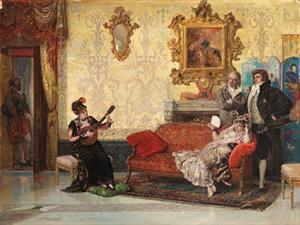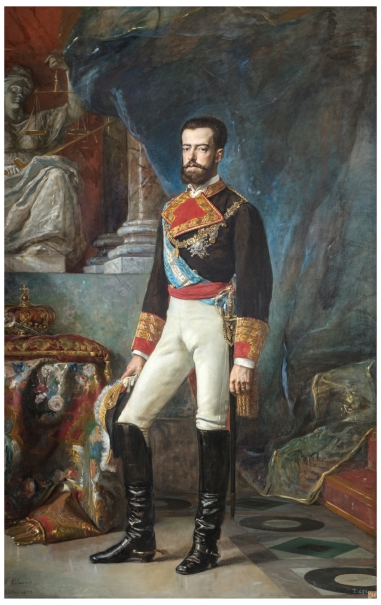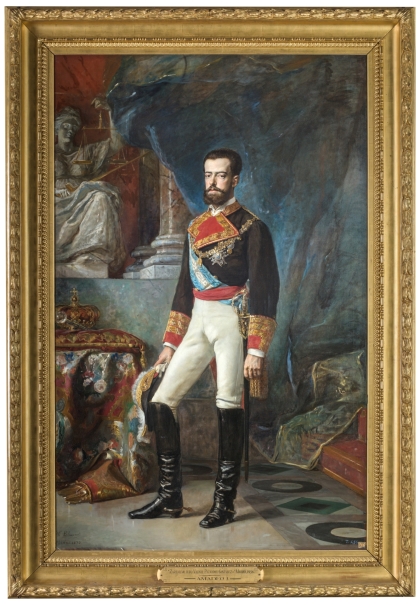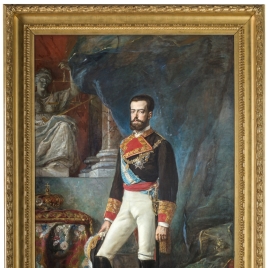Amadeus I
1872. Oil on canvas.Not on display
Amadeus I (Turin, 1845–1890), the ephemeral king – as Count de Romanones would call him years later – was elected constitutional monarch of the Spanish people on the 16th of November 1871 in the Congress of Deputies. This election took place after a long and complex international diplomatic process following the dethronement of Isabella II of Spain (1830–1904) in 1868, resulting in the Crown of Spain falling to the House of Savoy. The greatest advocate of Amadeo’s candidacy, General Juan Prim (1815–1870), was assassinated shortly before the arrival of the Italian king in Spain, who found himself without a defender in a setting of growing antipathy of the people towards the foreign monarch. His brief reign was full of complications, including an attempt on his life in the summer of 1872. Emilio Castelar (1832–1899) called on the king to surrender the Crown to Congress and even urged him to return to his homeland, lest he meet an end similar to that of Maximilian of Mexico. Indeed, unable to resolve the country´s troubled situation, Amadeo resigned the throne on 11 February 1873, and the First Republic was then declared. Vicente Palmaroli was a loyal servant of the new king during those two short years on the throne and was commissioned by the king to paint a large canvas depicting his reception at court, which is unknown. Palmaroli also acted as the person responsible for the accommodation of guests in the Palacio de Oriente and would arrange the decor of the official rooms for the new occupants. This portrait is the best representation of the painter´s relationship with the Savoy family, and in it, Palmaroli shows himself a sensitive and original court portraitist. In general, the portrait was modelled on those painted by Antonio Gisbert (Madrid, Complutense University) and Carlos Luis de Ribera (Madrid, Bank of Spain), which were also large and full-length and followed the prototype of the monarch in military uniform used since the reign of Ferdinand VII. Portrayed at the age of twenty-seven, Amadeo of Savoy wears the uniform and sash of captain general and sash and grand cross of the Order of Charles III as well as the collar of the gold fleece, which he holds, - not having the right to wear it as it is a dynastic order – in a display of the legitimacy of his status as king of Spain. Alongside these two decorations, the highest Spanish honours, he wears two small commemorative medals, of which only that of Victor Emmanuel II of Savoy, head of the house to which Amadeo I belonged, is recognised. An allegorical statue of Justice appears in the background, probably alluding to the laws that Amadeo swore to uphold. This statue also appears in some portraits of Alfonso XII, who shared with Amadeo the status of parliamentary monarch, subject to the laws of the Constitution. The iconography of the portrait is completed by the Regalia of Charles III, at the foot of the statue, which do not go unnoticed, as the weak justification of Amadeo´s dynastic rights in Spain was precisely because his mother, Maria Adelaide of Austria, was the great-granddaughter of that enlightened monarch. The portrait epitomises a clear and accessible staging of the new king´s legitimacy. Vicente Palmaroli´s composition is more visually striking than those of other portraitists of Amadeo, who were still purist in their approach. Aware of his own skills, the Madrid-born artist concentrates especially on recreating the sumptuousness of the palace with a rich, loose, precious brushstroke that stands out in the luxurious purple curtain in the background or in the fabric covering the buffet on which the crown is placed, thus emphasising the royal status of the sitter. The figure of the king, however, is modelled with realism and a firm, correct drawing that captures his grey personality with great precision. It is not for nothing that this figure is traditionally associated with a preparatory sketch (Madrid, Museo Municipal), which concentrates on the features of the Italian monarch and which may have been used in the present painting, although it has been doubted that it is the work of Palmaroli









